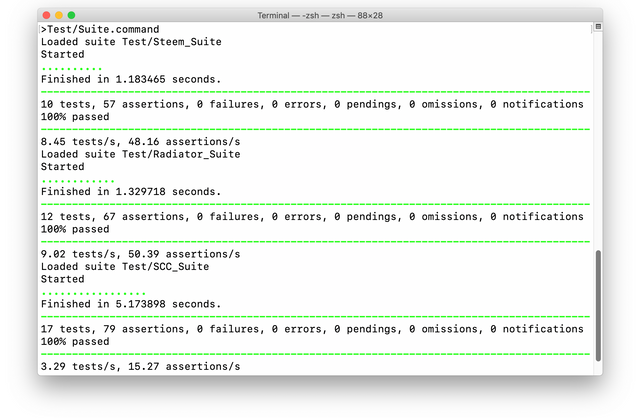
Repositories
SteemRubyTutorial
All examples from this tutorial can be found as fully functional scripts on GitHub:
- SteemRubyTutorial
- steem-api sample code: Steem_Suite.rb
- radiator sample code: Radiator_Suite.rb.
- steem engine sample code: SCC_Suite.rb.
steem-ruby
- Project Name: Steem Ruby
- Repository: https://github.com/steemit/steem-ruby
- Official Documentation: https://www.rubydoc.info/gems/steem-ruby
- Official Tutorial: N/A
steem-mechanize
- Project Name: Steem Mechanize
- Repository: https://github.com/steemit/steem-mechanize
- Official Documentation: https://www.rubydoc.info/gems/steem-mechanize
- Official Tutorial: N/A
radiator
- Project Name: Radiator
- Repository: https://github.com/inertia186/radiator
- Official Documentation: https://www.rubydoc.info/gems/radiator
- Official Tutorial: https://developers.steem.io/tutorials-ruby/getting_started
Steem Engine

- Project Name: Steem Engine
- Home Page: https://steem-engine.com
- Repository: https://github.com/harpagon210/steem-engine
- Official Documentation: https://github.com/harpagon210/sscjs (JavaScript only)
- Official Tutorial: N/A
What Will I Learn?
This tutorial shows how to write unit tests for Steem blockchain and Steem database using Ruby. When using Ruby you have three APIs available to chose: steem-api, steem-mechanize and radiator which differentiates in how return values and errors are handled:
- steem-api uses closures and exceptions and provides low level computer readable data.
- steem-mechanize drop in replacement for steem-api with more performat network I/O
- radiator uses classic function return values and provides high level human readable data.
Since both APIs have advantages and disadvantages sample code for both APIs will be provided so the reader ca decide which is more suitable.
Requirements
Basic knowledge of Ruby programming is needed. It is necessary to install at least Ruby 2.5 as well as the following ruby gems:
gem install test-unit
gem install bundler
gem install colorize
gem install contracts
gem install steem-ruby
gem install steem-mechanize
gem install radiator
Note: All APIs steem-ruby, steem-mechanize and radiator provide a file called steem.rb. This means that:
- When more then one APIs is installed ruby must be told which one to use.
- The tree APIs can't be used in the same script.
If there is anything not clear you can ask in the comments.
Difficulty
For reader with programming experience this tutorial is basic level.
Tutorial Contents
The various classes in described in this tutorial need trough testing. For this a variety of Test classes where created:
Implementation
Tests
Test are very easy to write. Just create a class descending from Test::Unit::TestCase and a methods to perform the tests. There are a variety of asserts to check for the desired results.
class Radiator_Amount_Test < Test::Unit::TestCase
def test_to_sbd_01
_test = Steem::Type::Amount.to_amount(1.0, Steem::Type::Amount::STEEM)
assert_not_nil(_test, "An amount should be created")
assert_instance_of(Steem::Type::Amount, _test, "The amount should be of type «Steem::Type::Amount»")
assert_equal(Steem::Type::Amount::STEEM, _test.asset, "The amount is if a «STEEEM» asset")
_sbd = _test.to_sbd
assert_not_nil(_sbd, "A sbd amount should be created")
assert_instance_of(Steem::Type::Amount, _sbd, "The amount should be of type «Steem::Type::Amount»")
assert_equal(Steem::Type::Amount::SBD, _sbd.asset, "The amount is if a «SBD» asset")
end # test_to_sbd_01
end # Radiator_Amount_Test
There are currently 29 test on GitHub to draw imspiration from. However unit tests tend to by quite repetitive so there is not point in showing multiple examples.
One speciality can be found in the Steem-Engine tests. Since Steem-Engine has no query option it is necessary to iterate over the whole database table. This is quite resource and time consuming so those tests should only be executed when the all option is added to the command line.
#!/opt/local/bin/ruby
require_relative '../Scripts/SCC/Balance'
require "test/unit"
unless defined?(Test_All) then
Test_All = ARGV[0] == "all"
end
class Balance_Test < Test::Unit::TestCase
# Thee “all” tests but considerable strain on the
# Steem Engine server so we only do them when
# explicitly requested
#
if Test_All then
def test_all_01
_test = SCC::Balance.all
assert_not_nil(_test, "There should be balances")
assert_instance_of(Array, _test, "balances should be an array")
_balance = _test[0]
assert_not_nil(_balance, "First balance should exist")
assert_instance_of(SCC::Balance, _balance, "First balance should be of type «SCC::Balance»")
assert_instance_of(SCC::Metric, _balance.metric, "First balance metric should be of type «SCC::Metric»")
assert_instance_of(SCC::Token, _balance.token, "First balance token should be of type «SCC::Token»")
assert_equal(:symbol, _balance.key, "First balance key should be «:symbol»")
assert_equal("ENG", _balance.value, "First balance value should be “ENG”")
end # test_all_01
end #if
end # Balance_Test
Suites
A collection of tests can be grouped to a test suite. All that is needed is to require the individual tests.
Steem-API
The Steem-API tutorial currently only use one class and so there is only one test in the suite.
#!/opt/local/bin/ruby
require_relative '../Test/Steem_Amount_Test.rb'
Radiator
The Radiator tutorial used a total of three classes each with its own test class.
#!/opt/local/bin/ruby
require_relative '../Test/Radiator_Amount_Test.rb'
require_relative '../Test/Radiator_Reward_Fund_Test.rb'
require_relative '../Test/Radiator_Price_Test.rb'
Steem-Engine
#!/opt/local/bin/ruby
require_relative '../Test/SCC_Test.rb'
require_relative '../Test/SCC_Contract_Test.rb'
require_relative '../Test/SCC_Token_Test.rb'
require_relative '../Test/SCC_Balance_Test.rb'
require_relative '../Test/SCC_Metric_Test.rb'
All tests
A test suite can call further suites to create a hierarchy of tests. However, steem-ruby, steem-mechanize and radiator are incompatible with each other so at the top level a shell script is used.
#!/opt/local/bin/zsh
Test/SCC_Suite.rb "${1}"
Test/Radiator_Suite.rb "${1}"
Test/Steem_Suite.rb "${1}"
The output of the Test/Suite.command command looks like this:

Curriculum
First tutorial
Previous tutorial
Next tutorial
Proof of Work
- GitHub: SteemRubyTutorial Issue #19
Image Source
- Ruby symbol: Wikimedia, CC BY-SA 2.5.
- Steemit logo Wikimedia, CC BY-SA 4.0.
- Steem Engine logo Steem Engine
- Screenshots: @krischik, CC BY-NC-SA 4.0







Congratulations @krischik! You have completed the following achievement on the Steem blockchain and have been rewarded with new badge(s) :
You can view your badges on your Steem Board and compare to others on the Steem Ranking
If you no longer want to receive notifications, reply to this comment with the word
STOPDownvoting a post can decrease pending rewards and make it less visible. Common reasons:
Submit
Hi, @krischik!
You just got a 9.89% upvote from SteemPlus!
To get higher upvotes, earn more SteemPlus Points (SPP). On your Steemit wallet, check your SPP balance and click on "How to earn SPP?" to find out all the ways to earn.
If you're not using SteemPlus yet, please check our last posts in here to see the many ways in which SteemPlus can improve your Steem experience on Steemit and Busy.
Downvoting a post can decrease pending rewards and make it less visible. Common reasons:
Submit
Downvoting a post can decrease pending rewards and make it less visible. Common reasons:
Submit
Note, as of
radiator-0.4.7(or just before, probably):So there was a time when you could not
requireboth radiator and steem-ruby in the same runtime. But now, they should co-exist fine.Downvoting a post can decrease pending rewards and make it less visible. Common reasons:
Submit
Well, radiator still provides a
steem.rbso I'm sceptical.But I'll give it a try — maybe with the right order it works.
Downvoting a post can decrease pending rewards and make it less visible. Common reasons:
Submit